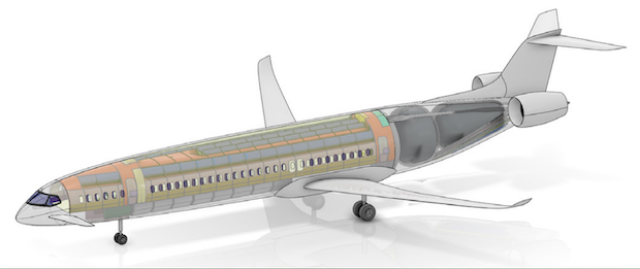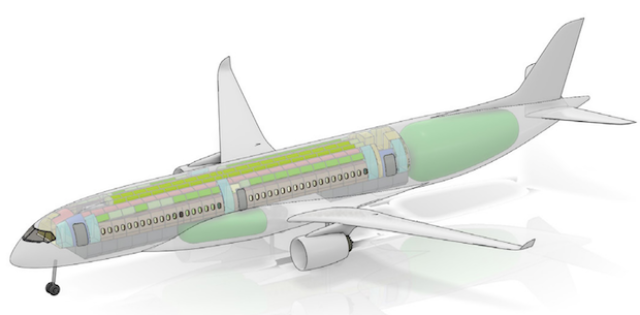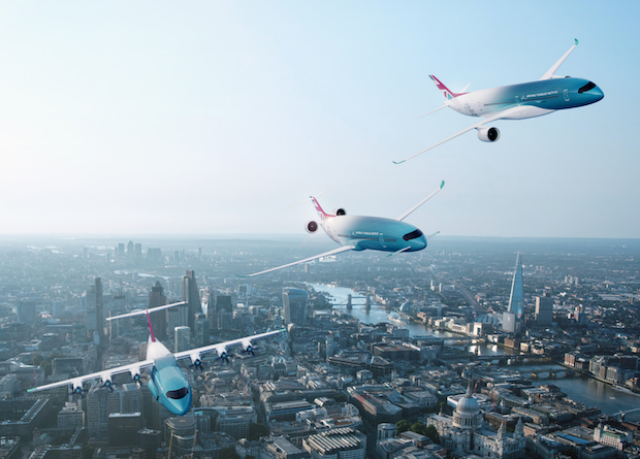The British Institute of Aerospace Technologies presented the concepts of three hydrogen aircraft — regional, narrow-body and wide-body. As a basis, the researchers took the designs of existing aircraft and adapted them to work on liquid hydrogen.
Hydrogen fuel is an attractive alternative to conventional aviation fuel. In gaseous form, it burns easily and relatively cleanly, and leaves only water and 90 percent less nitrogen oxide than kerosene. But since the energy density of hydrogen gas at normal temperature is much lower, it requires heavy and large high-pressure tanks for storage in liquefied form. If they are installed inside the fuselage, they reduce the number of seats. And if you increase the fuselage or hang a large fuel tank outside, the maximum take-off weight and drag of the aircraft will increase.
The British Institute of Aerospace Technologies has been leading the FlyZero project since 2020. Its purpose is to study the concepts of zero-emission aircraft. According to researchers, liquid hydrogen is the most promising option for large commercial airliners. They predict that from the mid-2030s, a new generation of hydrogen-powered aircraft with low fuel costs will outperform conventional aircraft in terms of operational performance.
Earlier, FlyZero showed how wide -body, narrow-body and regional hydrogen aircraft will look like. But he did not disclose detailed details about the conceptual aircraft.
On March 11, the British Institute of Aerospace Technologies presented the concepts of regional, narrow-body and wide-body hydrogen aircraft in their final version. They are based on the designs of existing aircraft — ATR 72-600, A320neo and Boeing 767-200ER - and outwardly resemble them. But the requirements for the storage of liquid hydrogen have led to the fact that the hydrogen versions have a much larger fuselage diameter.

FZR-1E
Image Source: FlyZero

FZN-1E
Image Source: FlyZero

FZM-1G
Image Source: FlyZero
The model for the FZR-1E regional hydrogen aircraft was the ATR 72-600, designed to carry up to 74 passengers. Compared to the latter, the FZR-1E is slightly longer (28 meters versus 27.2 meters) and has a large wingspan (31 meters versus 27.1 meters). And the diameter of its fuselage has been increased by 0.7 meters to 3.5 meters. This is due to the fuel cells located under the rear of the cabin, and the water storage system formed as a result of the "exhaust".
The cruising speed of the FZR-1E will be 601 kilometers per hour, and the range will be 1,480 kilometers. For comparison, ATR 72-600 has these indicators of 492.6 kilometers per hour and 829 kilometers.
The FZN-1E narrow-body hydrogen aircraft is an adaptation of the A320neo, which accommodates up to 194 passengers. Two tanks with liquid hydrogen, a fuel system and gas turbines are located in the back of it. To do this, we had to abandon the classic configuration with an underwing engine, change the tail to a T-shaped and add destabilizers on the nose to avoid problems associated with the center of gravity.
The fuselage of the FZN-1E is ten meters longer and almost a meter wider than that of the A320neo. And the wingspan is 39.3 meters compared to 35.8 for the A320neo. At the same time, the speed and flight range of a hydrogen narrow-body aircraft are assumed to be approximately the same as that of a conventional analogue — 833 kilometers per hour and 4444.8 kilometers.
The researchers took the Boeing 767-200ER as the basis for the wide-body FZM-1G concept. The engines of the 279-seat liner are located under the wing, and the tanks with liquid hydrogen are in an unpressurized zone opposite the wing. The fuselage diameter of the FZM-1G is six meters, which is even closer to the A350 or 777X airliners, and not to the 767-200ER. Its wingspan is 52 meters, and its length is 59.6 meters (the 767-200ER has 47.6 meters and 48.5 meters). The wide-body hydrogen aircraft will be able to fly up to 10.6 thousand kilometers with a cruising speed of 875.9 kilometers per hour.
The researchers claim that their concepts are just as safe as the aircraft on the basis of which they were created. But they note that cryogenic fuel has not been sufficiently studied. The second stage of the FlyZero project is not yet expected.
Earlier we wrote about the Airbus concern, which is going to test a hydrogen internal combustion engine on the A380 — the world's largest production airliner.
Vasilisa Chernyavtseva

